LOCATION: 1000 km from Ulaanbaatar by paved road, 102 km from Murun, a central town of Khovsgol province.
The freshwater Khovsgol Lake lies sticking into the southern fringe of Siberian Taiga on the northern frontier of Mongolia, at an altitude of 1645 m above the sea level.
This volcanic lake is the second largest in terms of surface area (2760 sq km) contains 70% of Mongolian freshwater sources and 1-2% of the world.
Its depth reaches up to 262 m, 136 km (85 miles) long, 36 km (22 miles) wide with 414 km coastline.
You might assume the lake’s water freshness imagining the water transparency of 24.5 m, which looks as blue as the Caribbean Lakes.
Khovsgol Lake and its surrounding is absolutely the highlight and top of north Mongolia attractions where many types of adventures and leisure holidays available.
Leisure holiday lovers could enjoy the natural setting while staying in one of the ger camps along the shoreline, hire a boat to one of the 4 picturesque islands, kayak, visit nomads to explore the Mongolian way of life, meet the representative of the reindeer herders, do leisure horseback riding, hike along the lake’s shore, through wildflower carpeted meadows, or forest clearings.
Adventure travelers can experience multiday horseback riding, climb one of the high mountain summits, hike among the Taiga forest, do scuba diving, fish, or try winter activities on its frozen surface.
Over 90 rivers feed the Khovsgol Lake while one flows out from its southern tip, the Egiin Gol River, the main road to Khovsgol Lake pass beside.
The lake starts freezing from the beginning of November and melts mid-May, but partially lasts till the beginning of June.
There are abundant choices of resorts, ger camps, guest gers, and guesthouses along the southwestern shore of the lake.
Few ger camps locate by its southeastern shore.
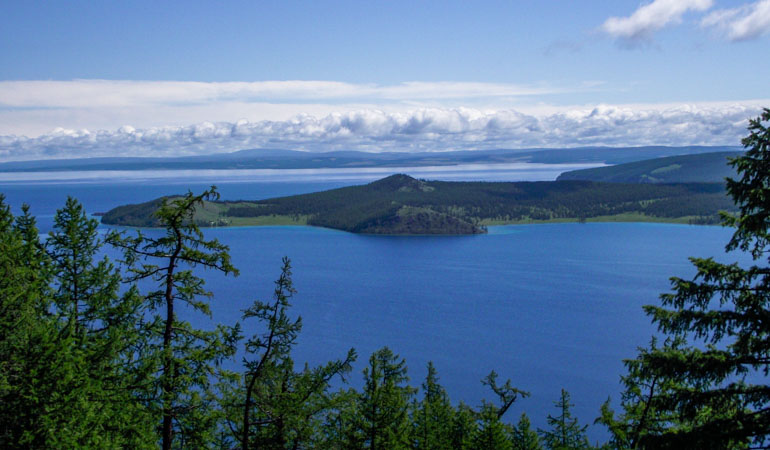
One of the last groups of nomadic reindeer herders in the world, the Reindeer people or Tsaatan tribe reside in the depths of Taiga in northern Mongolia. The tribe and Taiga best of north Mongolia attractions for adventure travellers.
There about 400 people of 70-80 families live in communities, usually a group of two to seven households in the mountains to the north and west of Tsaagaan Nuur soum, Khovsgol province.
Their life is entirely dependent on the reindeer they herd, often moving their small encampment tepees 5-10 times a year in search of suitable weather and moss for the reindeer.
Ethnically, the Reindeer people are Tuvans, has also known as the Uriankhai, Soyot, or Dukha, who speak a Uriankhai language distantly related to Mongolian.
They have been keeping their custom and tradition, supporting their life basing on the reindeer and residing in the teepee. According to their relationship with mother nature, shamanism is their belief. Therefore, the most famous shamans are among Tsaatans.
Except for the reindeer tribe, the pristine nature of the Taiga worth visiting.
Tsaatans proudly celebrated the 2000 Reindeer Festival in August 2019. Indeed, the reindeer number reached 2690 by 2020.
Tsaatans use the reindeer as the main way of transportation such as travel for hunting, the collection of firewood, as a pack animal for seasonal migrations, visiting relatives and friends, and traveling to the town for shopping and trade. Reindeer milk is part of Tsaatans’ staple food from which they make cheese, milk tea, butter, and yogurt. A reindeer gives 96-100 liters of thick and oily milk during the milking season. Tsaatans occasionally eat reindeer meat, but overall they prefer to increase the reindeer number instead of slaughtering.
Camping and renting a teepee are alternatives to stay in the Taiga.
Border control permission is required when traveling to Taiga. The permission is available at the Border Patrol in Murun.
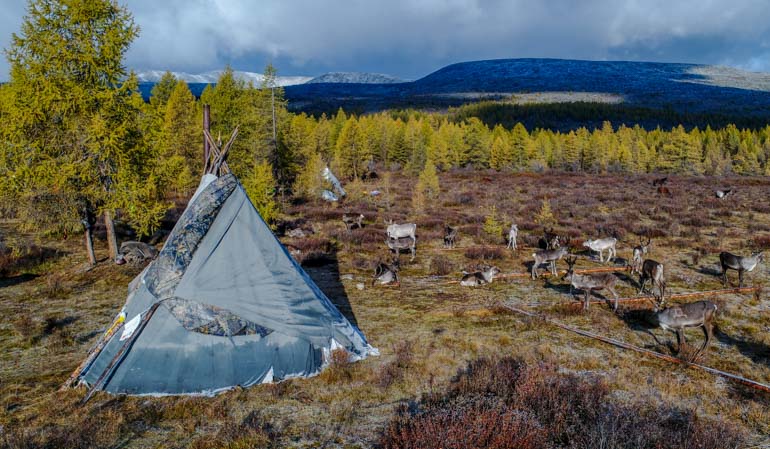
LOCATION: 360 km northwest of Ulaanbaatar, 35 km north of the Darkhan-Erdenet main road in Baruun Buren Soum (administrative unit), Selenge province.
Architecturally beautiful Amarbayasgalant monastery is one of the three main monasteries in Mongolia, was built between 1727 and 1737 by the Manchu emperor Yongzheng, the son of Kangxi of Manchu (Qing dynasty), commemorating Zanabazar, the first Bogd Gegeen (religious title), leader of Mongolian Buddhism, sculptor, and painter.
Amarbayasgalant monastery sets on the southern slope of Burenkhan Mountain in the picturesque valley of the Iven River.
Formerly, Amarbayasgaant had 40 temples, about 500 log cabins, and gers that resided by 2000-3000 monks during its peak years. Currently, there are 28 temples in four major courtyards, surrounded by 207m by 175m wall; those remained from the 1930’s communist purge. Restoration of the monastery began in 1988 with funds provided by UNESCO and private sources, after neglecting 50 years. The two-story 32m by 32m main temple Tsogchin Dugana is an architectural wonder. Its roof tile work and enamel ceilings are work of great craftsmanship. 4 middle pillars of Tsogchin Dugana acts as the rain duct connecting with tunnels under its floor.
There are 40-50 monks in residence, including young monks in training.
The religious ceremony is in process in the main two-story temple. 6 temples are open to the public and foreigners are required to pay an admission fee. The rest of the temples used to house mummified bodies of first Bogd Gegeen Zanabazar, third and fourth Bogd Gegeens.
The monastery keeps many famous original scripts of cultural heritage, including the 108 volumes of Ganjuur and the 226 volumes of Danjuur, written the ancient philosophy, medicine, geography, art, science, music, and astronomy in 1628. UNESCO registered this wonderful monastery as a World Heritage Site in 1996.
One of the splendid religious rituals Gongoriin Bumba sacrifice takes place in the Amarbayasgalant Monastery in mid-August – numerous local worshippers participate.
Several ger camps near the monastery accommodate visitors.
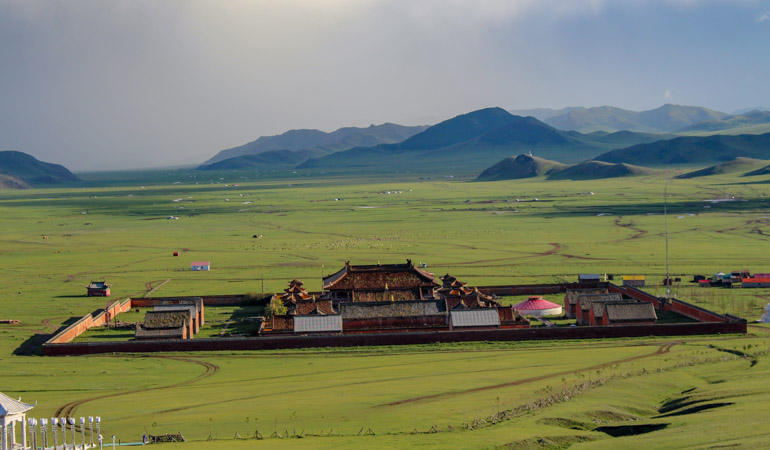
LOCATION: 660 km from Ulaanbaatar, 180 km northwest of Tsetserleg town, and just 4 km from Tariat soum (administrative unit) of Arkhangai province.
One of the natural highlights of Arkhangai province, the awe-inspiring Khorgo Terkhiin Tsagaan National Park comprises of two famous attractions: Terkhiin Tsagaan Lake or Great White Lake and dormant volcano Khorgo.
Among 10 volcanoes in the national park, 2210 m high Khorgo is spectacular, which became extinct about 8000 years ago. Larch tree forest covers the northern slope of the volcano. Its crater is 200 m in diameter, with a depth of 70-80 m.
Visitors climb the volcano on stairs and trails, and upon reaching the top, walk along the volcano rim with outstanding views of surrounding areas, bird’s eye view of Terhkiin Tsagaan Lake, and nearby town.
Astonishingly beautiful clear water lake Terkhiin Tsagaan formed after lava flows from the volcanoes blocked the north and south water access from the Terkh Rivers. The lake is renowned for its fish and birdlife, including the Ruddy Shellduck and Great Cormorant. There are 8 more inflows to the lake while only the Suman River sources out. The lake is 16 km long, 6-10 km wide, 20m deep, and lies 2060 m above sea level.
There are some local family-run guest gers and ger camps available between early June and late September.
Nomads and their fenceless grazing herds of livestock fill the national park. Therefore, nomad families stay available year-round.
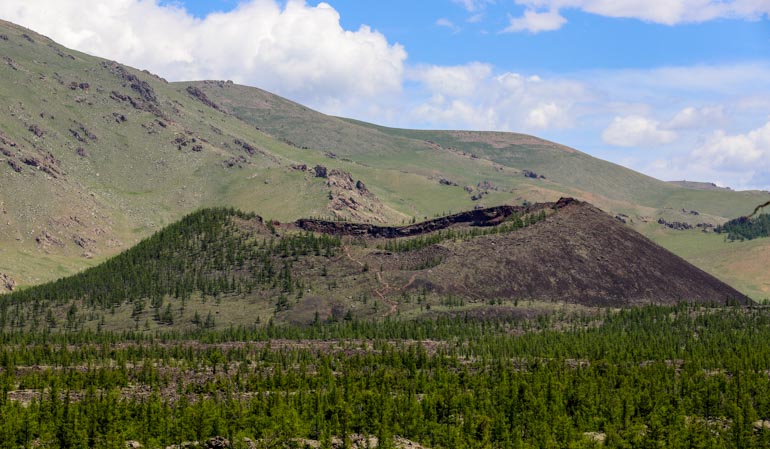
LOCATION: On the northern bank of Delger Murun, 16 km west of Murun town in Khovsgol province.
Bronze Age historical site Uushgiin Uvur contains 14 upright carved stones with heights of 1 to 4 meters, 20-50 centimeter thick, and 30-100 centimeter wide. Uushgiin Uvur deer stones are considered the best kept and clearest carved ones among the 600 deer stones found in Central Asia.
About 500 of the 600 deer stones were found in the territory of Mongolia. Deer stones are the first monuments of humans; the earliest of them belong to the 13th to the 9th century BC, while most of them date to The Bronze Age. On restored, standing stones, pictures including the sun, the moon, belts, knives, and jumping deer were carved fantastically. The deers are stylized with bird beaks, some of them gouged with spiraling horns, depicted as flying between the earth and heaven. Deer stones were not grave markers except for the later Bronze Age ones, but clan totems and worship sites. However, Uushgiin Uvur deer stones mark tombs.
Besides the deer stones, some 1400 tombs and offering site Khirgesuurs dot the valley.
You can access the deer stones easily from the central town Murun.
Most travel packages include the deer stone along the way between Murun and Khovsgol Lake.
Alternatively, you can stay at ger camp near the deer stone.
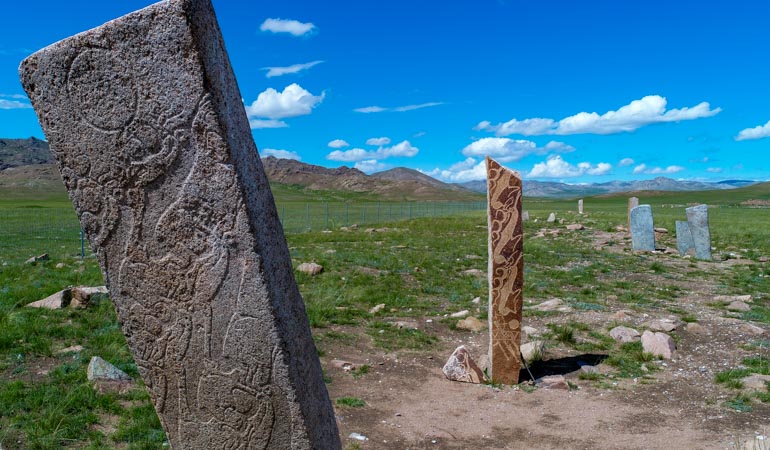
Copyright © 2025. All right reserved. Virgin Nature LLC